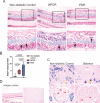Expression of the SARS-CoV-2 Receptor ACE2 in Human Retina and Diabetes-Implications for Retinopathy
- PMID: 34086044
- PMCID: PMC8185397
- DOI: 10.1167/iovs.62.7.6
Expression of the SARS-CoV-2 Receptor ACE2 in Human Retina and Diabetes-Implications for Retinopathy
Abstract
Purpose: To investigate the expression of angiotensin-converting enzyme 2 (ACE2), the receptor for SARS-CoV-2 in human retina.
Methods: Human post-mortem eyes from 13 non-diabetic control cases and 11 diabetic retinopathy cases were analyzed for the expression of ACE2. To compare the vascular ACE2 expression between different organs that involve in diabetes, the expression of ACE2 was investigated in renal specimens from nondiabetic and diabetic nephropathy patients. Expression of TMPRSS2, a cell-surface protease that facilitates SARS-CoV-2 entry, was also investigated in human nondiabetic retinas. Primary human retinal endothelial cells (HRECs) and primary human retinal pericytes (HRPCs) were further used to confirm the vascular ACE2 expression in human retina.
Results: We found that ACE2 was expressed in multiple nonvascular neuroretinal cells, including the retinal ganglion cell layer, inner plexiform layer, inner nuclear layer, and photoreceptor outer segments in both nondiabetic and diabetic retinopathy specimens. Strikingly, we observed significantly more ACE2 positive vessels in the diabetic retinopathy specimens. By contrast, in another end-stage organ affected by diabetes, the kidney, ACE2 in nondiabetic and diabetic nephropathy showed apical expression of ACE2 tubular epithelial cells, but no endothelial expression in glomerular or peritubular capillaries. Western blot analysis of protein lysates from HRECs and HRPCs confirmed expression of ACE2. TMPRSS2 expression was present in multiple retinal neuronal cells, vascular and perivascular cells, and Müller glia.
Conclusions: Together, these results indicate that retina expresses ACE2 and TMPRSS2. Moreover, there are increased vascular ACE2 expression in diabetic retinopathy retinas.
Conflict of interest statement
Disclosure:
Figures





References
Publication types
MeSH terms
Substances
Grants and funding
LinkOut - more resources
Full Text Sources
Medical
Miscellaneous

